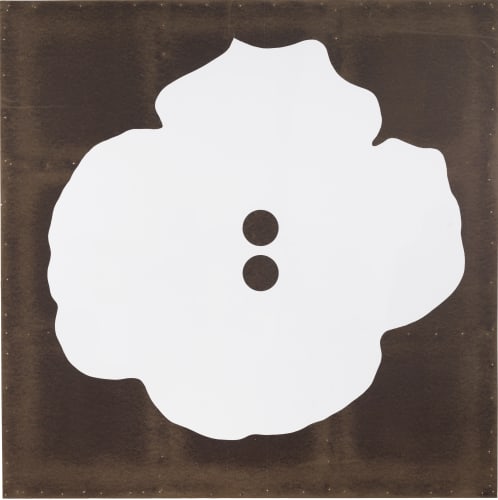Sultan’s interest in flower paintings resides in the fact that, as he has said, flowers are ‘intertwined with both the language of the human sensibility and the language of art.’
Evoking sportswear and activity, the exhibition title Button Down Modernism implies the wide range of associations that have rendered Donald Sultan’s work so complex and compelling.
Born 1951 in Asheville, North Carolina, the artist now lives and works in New York city. Conveying his reflections on art history and the zeitgeist, the flowers, fruit and other subjects taken from nature play a key part in works that have assured him a stellar place among U.S.-American painting’s august innovators. Sultan has received numerous accolades and awards, including three honorary doctorates; his works feature in major international museums and galleries, including the Metropolitan Museum of Modern Art in New York, Centre Pompidou in Paris, France, and Tate Modern in London, UK.
Inspired by his study of Eduard Manet’s works, in particular the 1880/81 painting Le Citron, Sultan embarked on his own exploration of nature. His mid-1980s piece, Lemons, initiated a revival of the floral still-life – with all the art-historical and philosophical implications associated with the genre. Since then, Sultan has been consistently concerned with subjects taken from nature. In several major cycles, including Oranges and Morning Glories, the artist has developed a strikingly reduced visual idiom that underscores the symbolism in his works. Moreover, the use of industrial materials has become his trademark.
Quite rare in contemporary art, the still-life, especially of flowers, was once considered an ideal vehicle for artists to convey their painterly skills and eye for composition, and to explore issues of perception and representation, form, colour and technique, as well as philosophical questions.
Sultan’s interest in flower paintings resides in the fact that, as he has said, flowers are ‘intertwined with both the language of the human sensibility and the language of art.’ In idiomatic expressions such as ‘rosy-cheeked’ or ‘fresh as a daisy’, as well as ‘pushing up the daisies’, flowers symbolise beauty, youth and vigour, as well as transience and death. In his paintings, however, with their references to history and art history, Sultan has added a crucial new element to the flower metaphor.
On the one hand, this is due to his unusual and complex technique involving the use of industrial materials such as tar, enamel paint, gesso or spackle and linoleum tiles or MDF panels. Alongside an expansive yet reductionist approach to his subject matter reminiscent of Pop-art and advertising iconography, the physical materiality of these works evokes the mass production of goods – including artificial flowers – in our highly mechanised and technological world. A perfect example can be found in his most recent series, Button Flowers, in which the holes in the ‘buttons’ represent stamens.
Sultan’s choice of paint and colour constitutes another key element. In the Button Flowers he has used matte aquamarine or egg-yolk yellow enamel paint. The colours, popular for cars in the late 1950s but rather less so today, add to the large-scale ‘flowers’ a hint of nostalgia, evoking an era of progress and optimism.
The artist has also commented on the ‘iconic button, against or concealing a geometric painting or pattern that could easily be a shirt or a jacket.’ More than that, however, the patterns in the background also evoke works by Piet Mondrian, the legendary founder of De Stijl, who believed that his austere art style ‘would end up destroying the old forms of state, religion and family ... creating new, simpler and better ones.’
The holes in Sultan’s Button Flowers afford not only a glimpse of the fabulous futures that were imaginable in the not-too-distant past, but also of our more muted expectations of what the future may hold.
Alice Henkes

